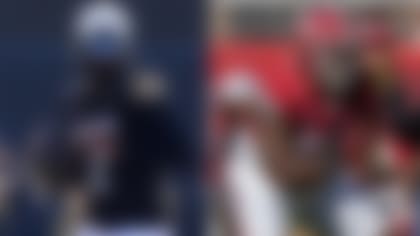We hear the term "situational football" often during a game, but do we really -- and I mean really -- understand what it means?
Yes, every football fan knows the situation of having to run out the clock for the win, or needing to get the ball back. But what about others? For instance, the situation on Monday night in San Francisco.
On NFL Replay
NFL Replay will re-air the
New Orleans Saints' 25-22 win over the San Francisco
49ers on Wednesday, Sept. 22 at 8 p.m. ET.
The 49ers fought diligently to get back into the game against the Saints, in spite of four turnovers and allowing a safety. They had the ball on their own 18-yard line and trailed by eight points with 2 minutes, 12 seconds remaining and no timeouts. They had 82 yards to navigate and needed to score a touchdown and have a two-point conversion play ready to go.
But that doesn't entirely cover the situation.
The 49ers also needed to make sure that when they scored they didn't leave the Saints enough time to march down the field and score. And with a strong wind at the Saints' back, this made a long field goal more realistic. So for the 49ers in this situation, scoring is important, but not scoring too fast is just as important.
You might be thinking the 49ers had to score whenever they could, regardless of time. Yet in this game situation you must think like a great pool player. You know you're going to make the first shot, but it's important to draw the ball back to set up the second shot.
How could they have done this? Simple: Treat the clock as a friend, not the opponent.
When the 49ers took the field at the 18, they needed to move the ball, but also as important was keeping the clock ticking. They had the freedom to work the middle of the field, thus running the clock to the two-minute warning.
The Niners gained 16 yards, then the two-minute warning came. On the next play, quarterback Alex Smith dropped back to pass, was forced to scramble and ran out of bounds. This was a bad decision on the part of Smith. The 49ers needed to start the clock; they needed to reduce the game as they moved the ball down the field. First-and-10 was the perfect down to move the clock, get it down to around 1:20 and then start to move the ball.
This situation has to be discussed before the start of the game-tying drive. It's not being negative to believe your defense can't stop a great offense, as it is more a case of being proactive to ensure your team can win the game. What good is tying the game to then lose on a last-second field goal? Be smart, move the clock as you move the ball.
This was a heart-breaking loss for the 49ers, unfortunately one that could have been avoided had they stayed in bounds a few times and milked the clock.
To go, or not to go
I've never been to a stadium where I've heard fans scream to kick the field goal on fourth down. Everyone wants the coach to be aggressive and go for it, figuring their team can overcome any mistakes later in the game.
Passing on points is an easy call for the fans, but when is it the right call for the coach?
On Sunday in Green Bay, the Packers were heavy favorites to beat the Bills. On the opening drive, they moved the ball down the field, only to stall on the Bills 26. Faced with a fourth-and-3, Packers coach Mike McCarthy sent out the field goal unit. Is this too conservative? Why not be aggressive and go for the jugular early in the game; surely the Bills can't keep pace with the Packers' offense.
The situation facing McCarthy was not as easy as it appeared, though. If the decision was made to kick the field goal and Mason Crosby missed, then McCarthy would have turned the ball over and given the Bills good starting field position. If McCarthy went for it and failed, he would have turned the ball over and given Buffalo a sense of confidence.
In that situation, he also must weigh the percentages of converting the fourth down to converting the field goal. If they are close, then he calls a play. But if they are one-sided (one way or the other), he must play the percentages.
The data supports McCarthy's decision. Crosby is only 10 of 15 at home in the 40-yard range, but his last miss was a year ago and before that in 2007. Clearly, Crosby can make the kick with better percentages than the Packers offense can convert the fourth down. I like the call, especially early in the game.
In Minnesota, a similar situation arose when the Vikings had the ball to open the game and drove down the field to the Dolphins 26. Ryan Longwell has only attempted nine field goals outside of 40 yards in the last three years, therefore I am confident the Vikings already knew they were going to go for it on fourth down before they called their third-down play.
Minnesota wanted to jump-start its offense, and with receiver Percy Harvin on the field they probably loved the matchups. However, the key to making the right decision on fourth down always centers on the third-down call. But with a false start, the Vikings went from third-and-3 to third-and-8, which then forced a different call on third down. But in trying to stay aggressive and with a smooth flow to the first drive, the Vikings figured the odds favored putting the ball in Favre's hand, instead of the foot of Longwell.
At the end of the game, the Vikings were faced with another fourth-down call. Trailing 14-10, the Vikings had a third-and-goal from the Miami 5. Using a spread formation, Minnesota gave Favre the option to call a run or pass, packaging two plays and giving Favre the option to call either one based on the alignment of the defense.
If the Dolphins were light in the box, Favre would run Adrian Peterson. But if they loaded the box, Favre had a pass play ready. The run got the ball down to the 1, with 2:21 on the clock and the Vikings still having all three timeouts, along with the two-minute warning. Easy call here, because failing to score would create horrible field position for the Dolphins, and with three timeouts remaining the Vikings would be able to get the ball back for one more try.
Nobody can question the decision, but the call is another story. Lining up in a right-handed formation and running the ball behind the team's two worst linemen is cause for concern. The Vikings have always been a left-handed run team behind Pro Bowl guard Steve Hutchinson. However, for some reason, the Vikings felt running right made the most sense. Peterson, on his sixth straight carry, was stopped for no gain.
I love the decision, hated the call.
» Follow me on Twitter @michaelombardi.



